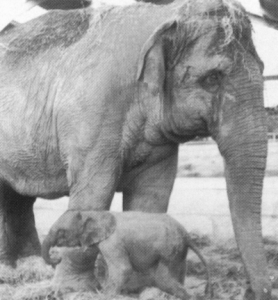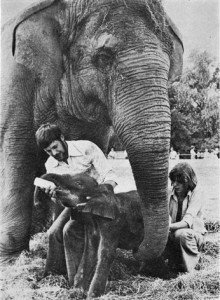Motty, the Hybrid Elephant

Motty is the little one
The Asian elephant Elephas maximus and the African elephant, Loxodonta africana are not only regarded as different species, but also belonging to different genus. Crossbreeds between two individuals, belonging to the same genus, but different species, are in most cases sterile, like the the mule, while a crossbreed between to genus was regarded as impossible – but it had never been tried, because of the natural geographical distribution of the two species in the wild.
However, in captive situations, an artificial environment is created, in which the two species interact. So, in 1978 in Chester Zoo, England, when the Asian elephant cow “Sheba” gave birth to a calf with an African elephant bull “Jumbolino” as father, scientists became puzzled. The staff had observed several matings between the elephants, but since a cross was thought to be impossible, none expected a delivery. The male calf, named Motty, had an African elephants cheek, ears and back, while nail numbers, (5 front, 4 hind) and the single trunk finger were like Asians. His paternity was determined through immunalogical tests. Sadly, this sensational elephant died two weeks after the birth. It was an early birth and Motty had stomach problems.
Dr Derek Lyon was veterinairy in charge at Chester Zoo during Motty’s birth.
This is his story about the event:
“I hope you find the following of some interest as several people believed that our cross-bred never occured! Believe me it did. The following is a brief resume.
Mother “Sheba” – arrived Chester Zoo 13/2/65 aged 9 yrs. Had a dead Asian baby born 26/10/74 – father “Nobby” (Asian). Sheba’s second pregnancy was result of mating with African bull “Jumbolina” (Bubbles). Bubbles arrived at Chester on 14/8/64 from the North Rhodesian Wildlife Conservation Society. “Motty” was born on 11/7/78. The suspicion of pregnancy was somewhat doubted at the time as it was ONLY possible for her to be pregnant to with “Bubbles” and crossbreds were not believed to have been possible. “Nobby” had been destroyed at a time earlier that would have been impossible for him to have been the father. Clinical signs during “Sheba’s” pregnancy consisted of the appearance of a fluid filled area along the ventral abdominal wall in Feb 1978. By May 1978 this swelling had persisted and increased in size to about 2 feet in length and 7-8 inches wide. By 1/7/78 the swelling had gone (oral diuretics had been given previously) and abdominal enlargement was noted, particularly on the left hand side.
For several months during the later stages of her pregnancy “Sheba” spent a considerable amount of time on her own. On 10/7/78 parturition initially started with production of small amounts of a milky vulval discharge. “Motty” was born on the outside paddock at 9.20am on 11/7/78. Foetal membranes were removed by the keepers and the placenta followed almost immediately. The other Elephants were taken and kept inside away from “Sheba” and calf who both remained outside. From the calf’s size it was thought to be premature(?). Initially, hourly feeds of glucose were given and later that day supplemented by hourly feeds consisting of cow’s milk/Sheba’s colostrum/Duphalyte (electrolytes, vitamins, amino acids and dextrose) and a vitamin supplement (Abidec).

Motty is the little one
The calf during this time had not yet stood. By 9.20pm on 12/7/78 the calf was standing and walking after 36 hrs of recumbency since his birth during which time the keepers had aided and encouraged standing by packing straw beneath the calf. On 13/7/78 “Sheba” and “Motty” were reintroduced to the rest of the herd on the outside paddock and the calf later allowed to the inside house for the first time. Hourly bottle feeding continued up to 12.30pm on 14/7/78 when it was possible for the calf to suckle from “Sheba” for the first time. By 10.00pm on 15/7/78 “Motty” was suckling normally and bottle feeding was stopped. A laboratory analysis of colostrum obtained earlier revealed:
- FAT 3%
- SOLIDS NOT FAT 8.03%
- TOTAL SOLIDS 11.03%
- PROTEIN 3.27%
- LACTOSE 2.95%
- ASH 1.81%
On 18/7/78 the calf developed an umbilical infection – treated with oral and topical antibiotcs. After 48 hrs the calf appeared to have recovered and was feeding and sleepng normally. At 9.00 am on 21/7/78 the calf was found comatose and dying and despite being given extra warmth, cardiac stimulants, artificial respiration and chest massage died an hour later. Post mortem revealed death to be due to necrotic-enterocolitis and E coli septicaemia. All very, very sad.”
1998-01-17 Derek Lyon, former veterinairy at Chester Zoo
DETAILS OF THE HYBRID ELEPHANT CALF
- Ears – Large, African shaped with pointed lobes
- Head – Sloping forehead with one dome and two smaller ones behind
- Trunk – Deeply wrinkled, like African, but with one finger at the tip
- Body – Overall like African, with centre hump as in Asian, and hump in rear as in African
- Tail – Long, hangs below the ankle, flat with hairs in small groups forming two rows, one row on each edge,
- Foot – Asian, fore-feet five nails, back-feet four nails
- Legs – Long and slim like African
These details are from Phil Walley, Elephant Keeper of the Chester Zoo
“Motty’s” story was published in three places with pictures clearly depicting the mixed African and Asian characters:
- “Elephant”, Volume 1, Number 3, pages 36-41.
- “Elephants: Majestic Creatures of the Wild”, pages 168-171.
- “The Proboscidea: evolution and palaeoecology of elephants and their relatives”, pages 53-54.
